You’ll find Sunset Crater a striking place to camp, with lava fields, cinder cones, and dark-sky views just steps from your tent or RV. Bonito Campground offers serviced sites and easy access to family-friendly trails, while backcountry options let you experience raw volcanic terrain if you follow permit rules and Leave No Trace. Follow a few simple tips and you’ll be set for hiking, stargazing, and exploring—but there’s more you’ll want to know.
Why Sunset Crater Is a Must-Visit for Campers
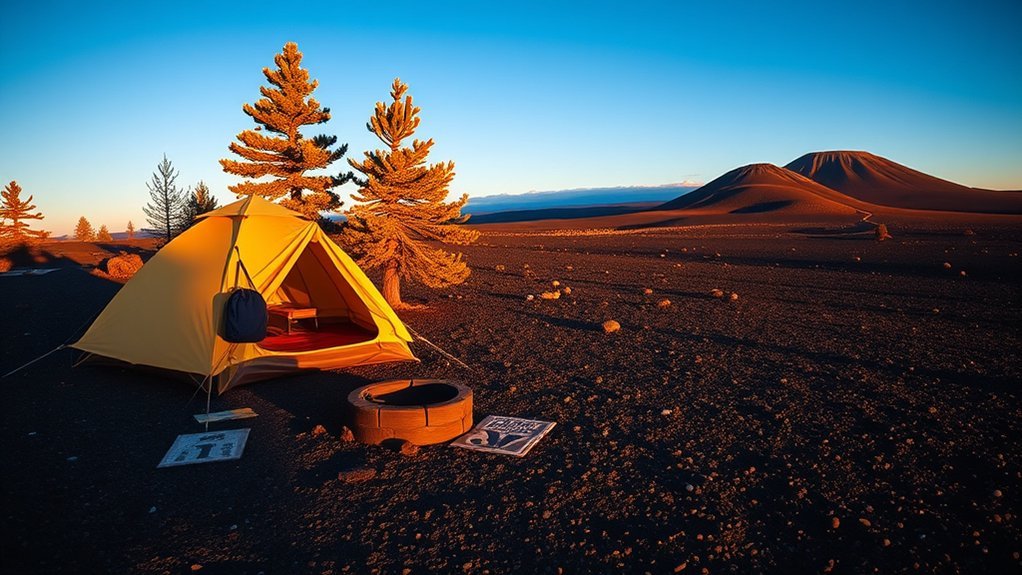
Because Sunset Crater is one of the youngest volcanoes in the U.S., it offers campers a rare chance to sleep among dramatic cinder cones and windswept lava fields while still enjoying modern comforts at Bonito Campground—30 sites with flush toilets, drinking water, and picnic tables—and seasonal access from late May to mid-October, making it easy to plan a trip that includes daytime hikes like the Lava Flow and Lenox Crater trails and unforgettable moonless-night stargazing in an International Dark Sky Park. You’ll find Sunset Crater Volcano National Monument ideal if you want hands-on volcanic history, striking landscapes, and accessible hiking trails. Camping here places you beneath ponderosa pines, beside rugged lava fields, and under brilliant stargazing skies. Pack layers, sturdy boots, and curiosity.
The Bonito Campground: What to Expect
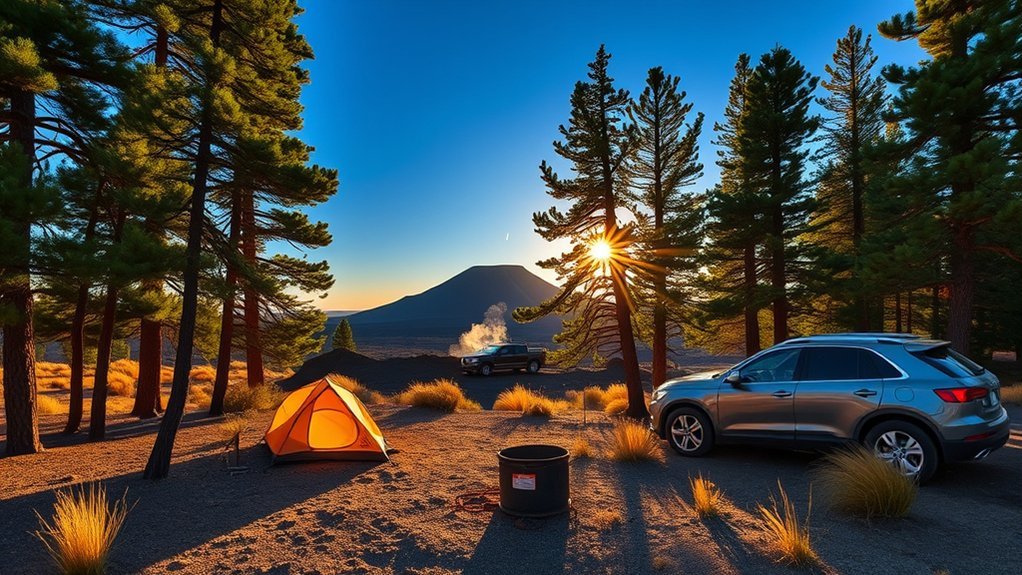
If you’re planning to camp at Sunset Crater, Bonito Campground is where you’ll set up base—nestled on the Bonito Lava Flow beneath tall ponderosa pines and open seasonally from late May to mid-October. You’ll find large sites with paved parking suitable for RV sites and tents, each equipped with picnic tables, grills, and fireplaces; note there are no electrical or water hookups. Clean restrooms with flush toilets and drinking water make stays comfortable. Wildlife like gray squirrels, stellar jays, hummingbirds, and ravens add life to mornings and evenings. The campground sits close to the Sunset Crater Volcano National Visitor Center, so you can grab maps, learn about the volcanic landscape, and access nearby hiking trails easily.
Trails and Lava Features to Explore
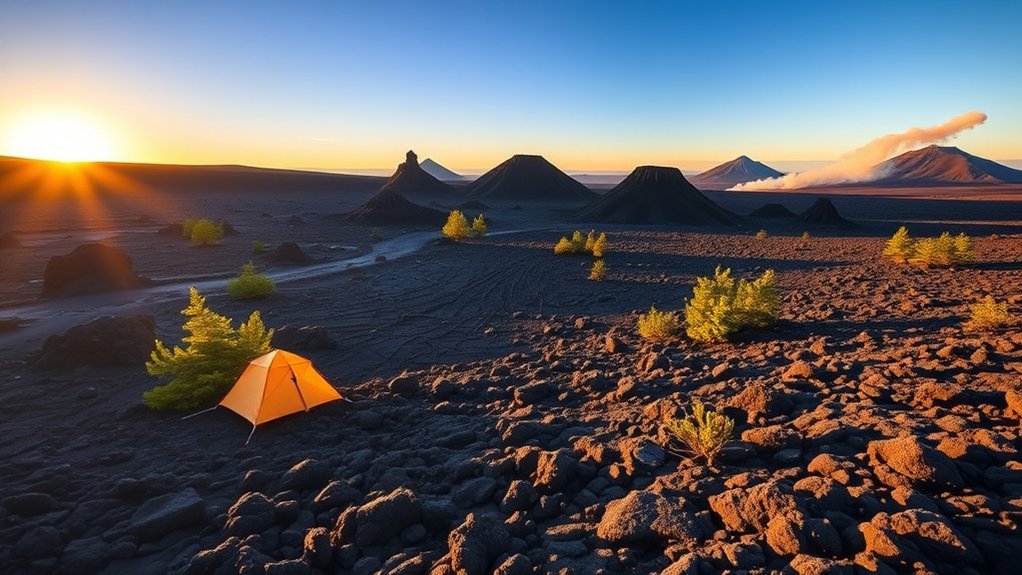
When you head out onto the monument’s trails, you’ll encounter a compact but varied landscape of cinder cones, jagged basalt, and broad lava fields that’s easy to explore in a day. You can hike the family-friendly Lava Flow Trail, a 1-mile loop with close-up views of Sunset Crater and surrounding lava. For longer outings, Lava’s Edge Trail stretches 3.4 miles out-and-back along the Bonito Lava Flow, passing striking geological formations and jagged rocks. Lenox Crater Trail climbs 1.6 miles and 300 feet to the crater rim, where you can peer into the cinder cone and see the San Francisco Peaks. Trails have interpretive signs explaining geology and Native American connections. Start early, carry water, and wear sturdy shoes for rough basalt.
Backcountry Camping Tips and Regulations
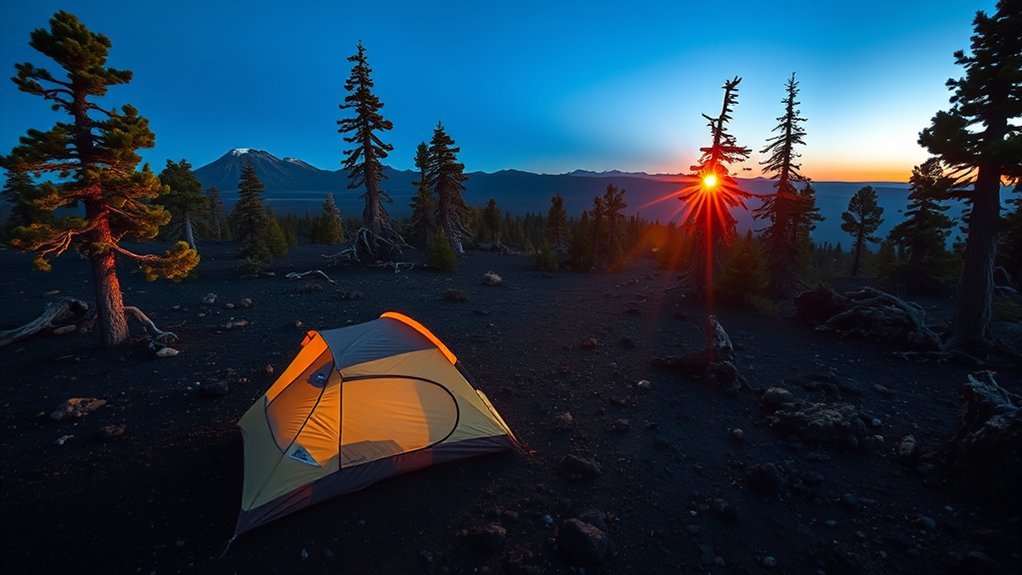
Although the monument’s backcountry feels remote, you’ll need a permit from the visitor center or the park website before you camp, and you must follow specific rules to protect the fragile lava landscape. For backcountry camping, follow Leave No Trace: pack out all trash, avoid trampling vegetation, and leave natural resources as you found them. Dispersed camping is allowed in designated areas only; stay at least 300 feet from roads and a quarter mile from water sources to reduce environmental impact. Fires are prohibited, so bring a lightweight stove for cooking and a reliable fuel supply. Campsites are limited to 14 consecutive days, then you must move at least 25 miles. Plan, respect rules, and you’ll enjoy a low-impact visit.
Nighttime Activities: Stargazing and Photography
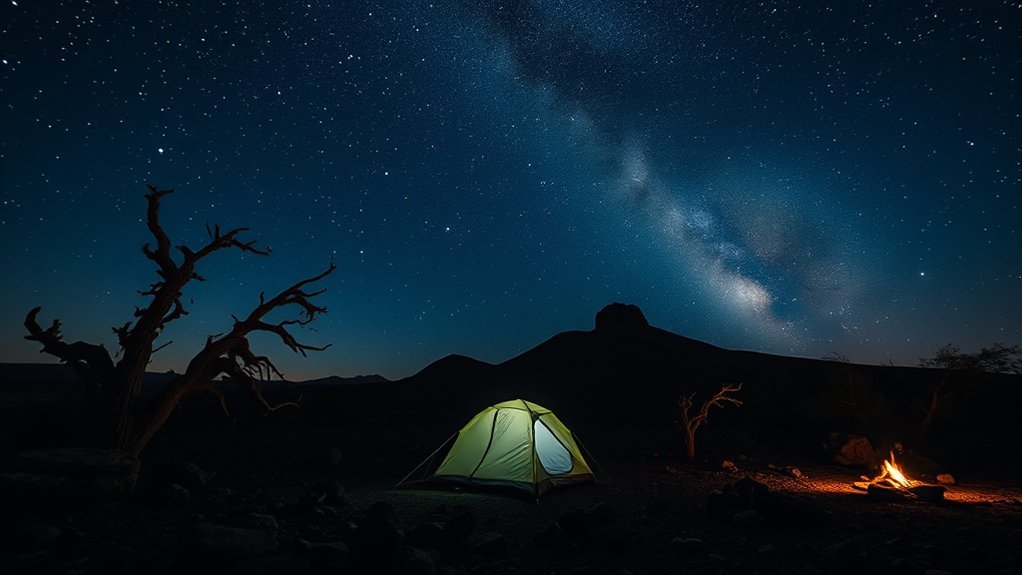
Ever wondered how the Milky Way looks away from city lights? At Sunset Crater Volcano National Monument, the International Dark Sky Park status gives you a dark sky and vivid experience ideal for stargazing and astrophotography. On moonless nights you’ll see crisp celestial features and the Milky Way arching over unique geological formations — perfect foregrounds for photography.
- Bring telescopes for deep views and binoculars for sweeping constellations; set up before moonset for best light.
- Use a sturdy tripod, wide-aperture lens, and long exposures for astrophotography; experiment with foreground silhouettes against lava fields.
- Respect darkness rules: red lights only, minimal noise, and leave no trace to keep the park dark for everyone.
Plan around moon phases and enjoy clearer, more memorable nights.
Frequently Asked Questions
Can You Camp at the Sunset Crater?
Yes — you can camp at Sunset Crater; Bonito Campground offers Campground Amenities, scenic Views, and access to Volcano Features and Hiking Trails. Follow Camping Regulations, Fire Restrictions, check Reservation Tips, Visitor Center, and watch for Wildlife Encounters.
What Is the Difference Between Camping and Backcountry Camping?
Think of camping as a cozy village, while backcountry’s the lone trail: you’ll choose campsite selection, gear recommendations, safety tips, Leave No Trace, campfire regulations, wildlife encounters, cooking methods; plan for family camping, solo adventures, seasonal considerations.
What Does a Backcountry Campsite Mean?
A backcountry campsite is a remote, primitive site you hike into, requiring backcountry permits, adherence to campsite regulations and Leave No Trace, proper camping gear, trail navigation, wilderness survival knowledge, campfire safety, wildlife encounters awareness, and environmental conservation.
Where to Camp When Going to Crater Lake?
Over 99% of visitors pick rim campgrounds; you should reserve or try first-come spots near the rim, scout camping spots, perfect tent setup, check campground amenities, hiking trails, fire regulations, wildlife encounters, weather considerations, equipment checklist, local attractions, safety tips.
Conclusion
Camping at Sunset Crater gives you a rare chance to sleep beside volcanic landscapes and dark skies. Bonito Campground’s 30 sites fit tents and RVs, while backcountry permits let you explore more—just follow Leave No Trace. Hike the easy Lava Flow Trail and spot unique lava features, then stargaze in an International Dark Sky site. Fun fact: over 90% of visitors rate stargazing as their favorite activity, so bring a blanket and a camera.

